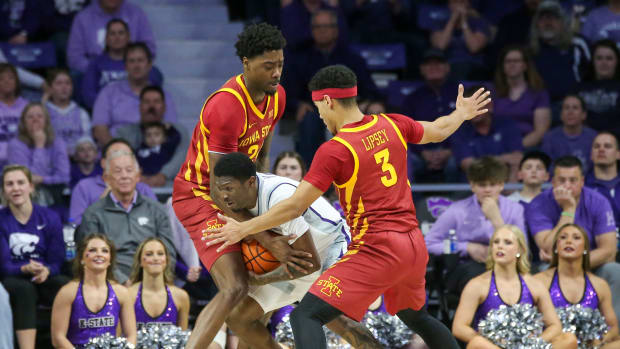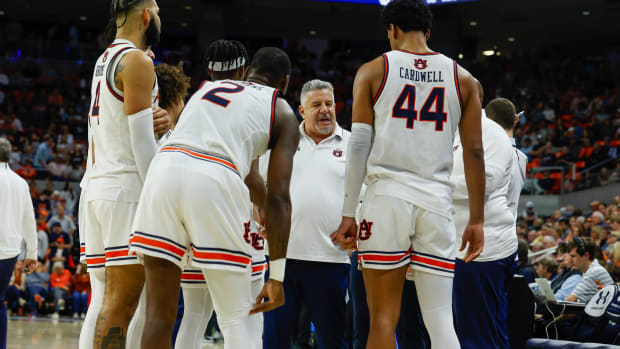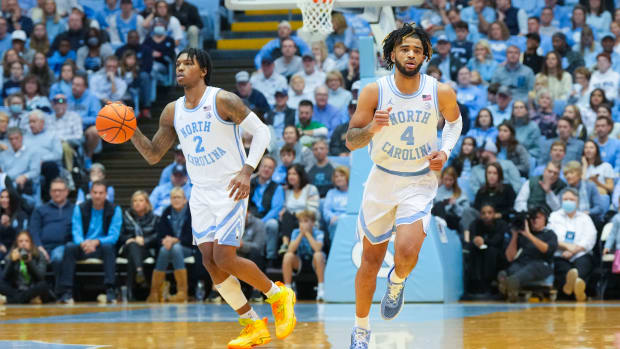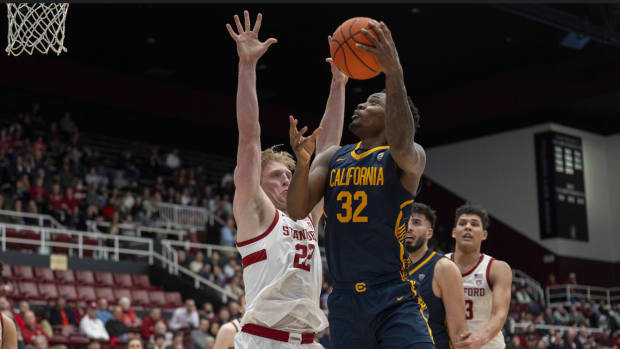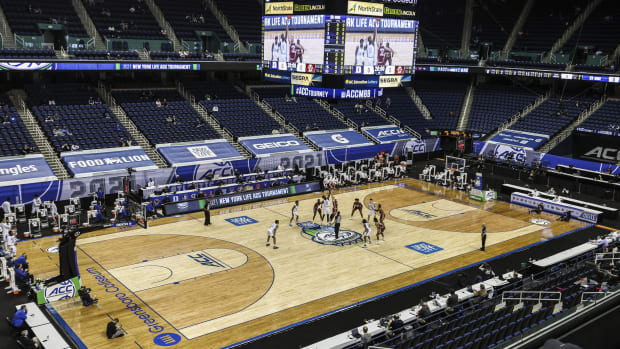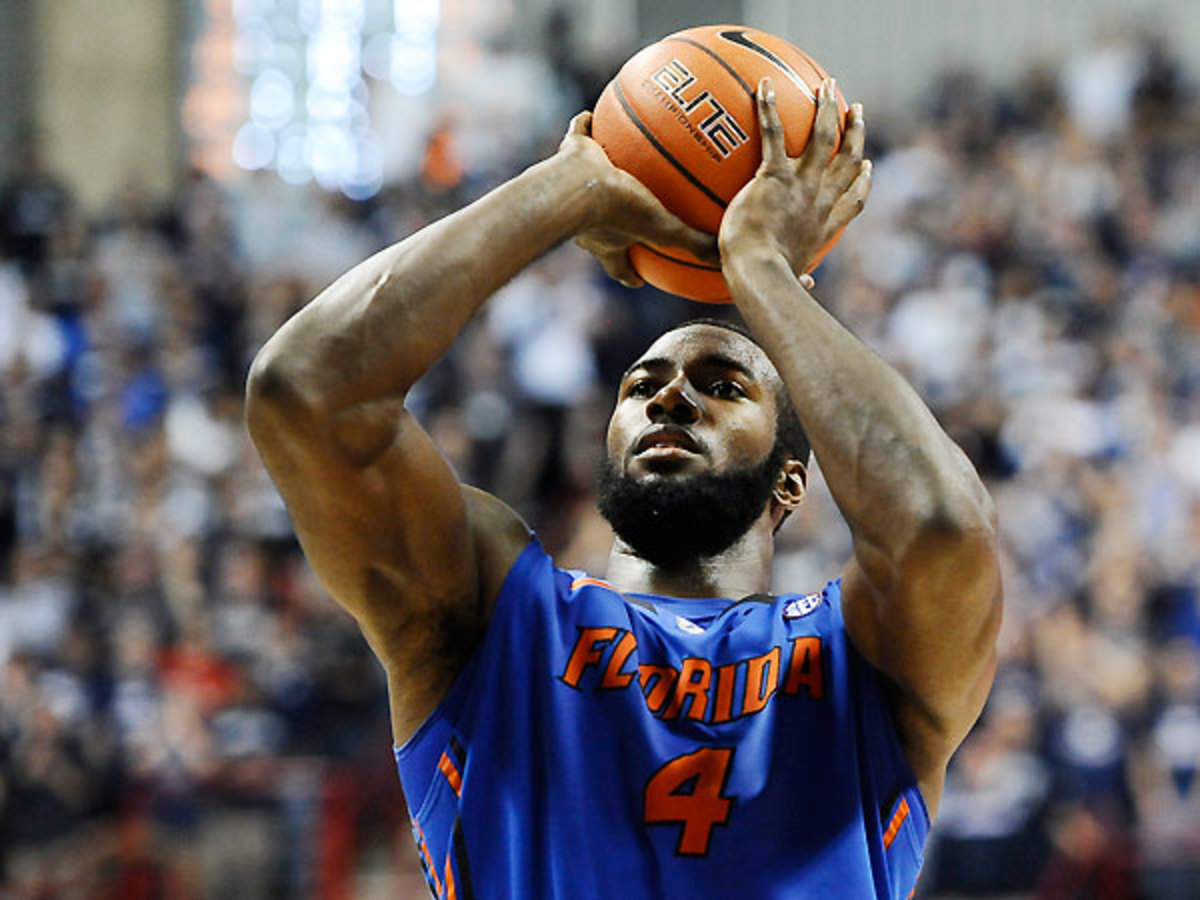
Florida nears full-strength, Pitt tries to prove itself in Jimmy V Classic
Patric Young provides a key presence in the paint for the Gators, who are approaching full-strength for the first time this season. (Jessica Hill/AP)
There's no doubt that No. 15 Memphis vs. No. 16 Florida is the Jimmy V Classic's marquee matchup -- it's one of the best college basketball games this week. But don't overlook the early game, Cincinnati vs. Pittsburgh. Here are a pair of storylines to watch for tonight.
Has Florida Turned the corner?
In the first four weeks of the season, Florida lost the only two games it played against top 25 teams. The rest of its early schedule featured cream puff opponents – save one home game against Florida State. Those games said very little about Florida’s long-term outlook, because it didn’t have all of its players available – a product of injuries, suspensions and academic shortcomings.
When Florida took on then-No. 13 Kansas last week, it was close to full-strength. Which is why the Gators’ performance -- an impressive six-point win in which Florida scored 1.05 points per possession and limited Kansas to just 0.95 PP – was so encouraging for their long-term outlook. It offered a glimpse of how good Florida can be when most of its major contributors are available. Point guard Scottie Wilbekin, who suffered an ankle injury late in Florida’s loss to the Huskies, turned in one of the best games (18 points, six assists) of his career. Forward Dorian-Finney Smith shot 4-of-6 from three-point range for 15 points. Center Patric Young was the physical interior presence Florida needs him to be and outplayed Kansas big man Joel Embiid.
Florida looked good against the Jayhawks.
The Gators will still be missing one important player, freshman forward Chris Walker, when they take on Memphis in the second game of Tuesday night’s Jimmy V Classic Doubleheader, but if they play as well as they did against Kansas, his absence might not matter. The once-depleted Gators have talent and athleticism in their backcourt and frontcourt, an All-SEC caliber guard (Wilbekin, who was named the SEC’s player of the week last week), a sharp-shooting perimeter threat (Michael Frazier) and an effective, if not offensively skilled, veteran center (Patric Young). If they can build off their performance against Kansas, the Gators have the potential to be one of the best teams in the country.
Memphis has shown it can beat elite teams – it knocked off no. 7 Oklahoma State on a neutral court in the championship game of the Old Spice Classic – so it would not be surprising if the Tigers upended the Gators. The first thing most observers point out about Memphis is its backcourt, which is really, really good. Michael Dixon, Geron Johnson, Chris Crawford and Joe Jackson are so skilled and versatile, most opponents don’t have the length and athleticism required to guard them.
What’s gone largely unnoticed is the improvement of forward Shaq Goodwin. The sophomore has nearly doubled his scoring average (7.4 points per game last season compared to 13.6 this season), is grabbing more rebounds (4.4 per game to 6.5), blocking more shots (1.1 to 1.8) and playing more minutes (20.7 to 26.1). Goodwin’s advanced statistical profile tells a similar story: He is producing 30 points more per 100 possessions than last season, grabbing a higher percentage of defensive rebounds (12.4 to 14.2), playing a higher percentage of available minutes (51.3 to 65.3) and his effective field goal and true shooting percentages have skyrocketed (46.6 to 66.7; 50.9 to 67.8).
Any sweeping conclusions made this early in the season about one player’s performance must come with the typical small-sample-size caveat. Goodwin may not be able to sustain his improvement over the course of the entire season, but should he play well against Florida – one of the two best teams in the SEC – it bodes well for his development. If Goodwin can complement Memphis’ elite backcourt with consistent interior scoring, this could (re: should) be the best team Josh Pastner has coached at Memphis.
Whether that will show Tuesday night is an open question.
How good is Pitt?
This is not an unfamiliar question this time of year. Pittsburgh has developed a reputation for crafting easy non-conference schedules, and this season is no different. Ken Pomeroy’s non-conference schedule metric ranks Pittsburgh’s non-conference schedule 319th out of 351 Division 1 teams. The best team Pitt has played so far is Stanford, who is ranked 46th in Pomeroy’s ratings and has already lost at home to BYU.
Pitt’s lack of quality competition may explain why it has yet to be ranked in both major polls this season. Pomeroy’s ratings are more bullish on the Panthers. They rank 12th in offensive efficiency, 19th in defensive efficiency and seventh overall.
Which ranking is a more accurate gauge of Pittsburgh, the AP poll or Pomeroy’s ratings?
It’s probably too early to tell, but we know this much: Pittsburgh’s players have taken note of the lack of national respect they’re getting.
"I'd be lying to you if I told you I don't look at those rankings," guard Cameron Wright told the Pittsburgh Post-Gazette Friday. "It provides a bigger chip for our team. I feel like we will get ranked but until then we will just take it one game at a time. I feel like we are getting some recognition but they just don't want to throw us into the rankings yet. We just have to focus on our opponents and whatever happens, happens."
Unfortunately, Tuesday night’s game against Cincinnati may not reveal much about the Panthers. The Bearcats are one of the better defensive teams in the country (27th in defensive efficiency), but their offense often stagnates, particularly when Senior guard Sean Kilpatrick struggles. Cincinnati has lost the only two games in which Kilpatrick has failed to register an offensive rating higher than 102. Those two games, a road tilt at New Mexico and a neutral court meeting with Xavier,are the last two games Cincinnati has played. The Bearcats could compete for an NCAA Tournament berth, but they're not a lock.
A convincing win Tuesday could finally push Pitt into the top 25 of the polls. A loss might provide some clarity about a team that has played one of the weakest non-conference schedules* in the country.
* Pittsburgh’s non-conference schedule this season is a typical Pittsburgh non-conference schedule. On its face, the meaning of that statement seems obvious: Pittsburgh hasn’t really played anyone. That’s true, but there’s another, statistically grounded reason why Pitt’s non-conference schedule is so similar to the ones Dixon has helped devise in recent years. The Panthers are masterfully exploiting what SI’s Luke Winn terms the “efficiency vs. RPI gap.” While Pittsburgh’s non-conference schedule is ranked 319th by Pomeroy’s Pythagorean efficiency formula, it’s ranked 158th by the RPI-based metric – a gap of 119.
What this means, in essence, is that Pitt’s non-conference schedule will look far better in the eyes of the NCAA Tournament selection committee, which uses the RPI-based NCSOS ranking, than its true level of difficulty suggests it should. The Panthers’ non-conference schedule is exceedingly weak, and Pomeroy’s efficiency NCSOS measure reflects this and ranks it accordingly. But the RPI NCSOS – which uses raw winning percentage – doesn’t accurately gauge how weak Pitt’s schedule is, which should boost the Panthers’ standing in the eyes of the selection committee. Pitt is, as Winn writes, playing “next-level scheduleball.” For some perspective, the gap between Pitt’s efficiency NCSOS and RPI NCSOS (119) falls short of the team’s 2011 gap (123), but ranks higher than its 2010 (109) and 2012 (90) gap.
Statistical support for this post provided by Kenpom.com.

